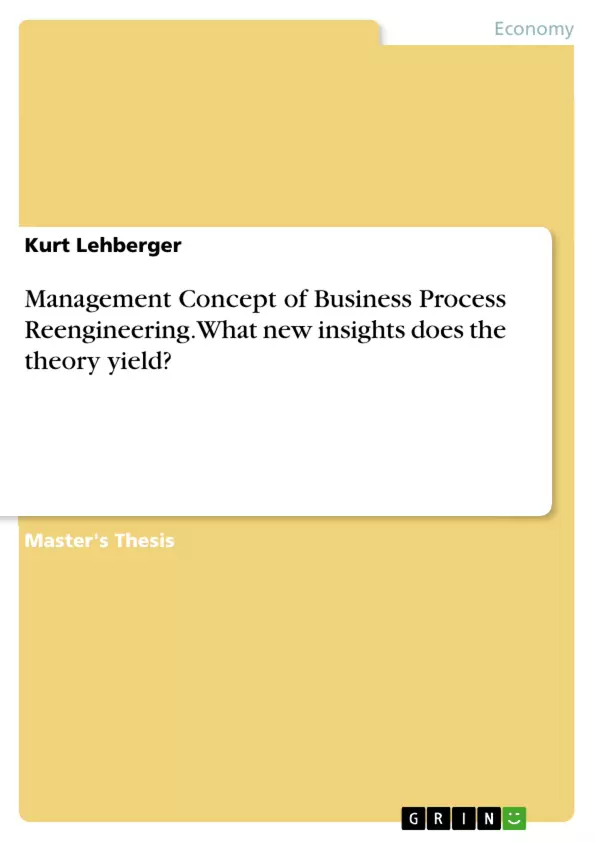The objective of the thesis is the outline of the management concept of Business Process Reengineering. Within that scope there are the clarification of terms, the outline of the process model and the classification into the existing management and organisational theory. The following questions are reasoned: What new insights does the theory yield? What will endure, what is useful in increasing the performance of the company? Which elements of the theory are conditionally applicable and have to be considered differently and adapted or developed further?
Inhaltsverzeichnis (Table of Contents)
- 1 OBJECTIVES AND STRUCTURE
- 2 DEFINITION: BUSINESS PROCESS REENGINEERING
- 2.1 Dimension: Business
- 2.2 Dimension: Process
- 2.2.1 Core and Support Processes.
- 2.2.2 Process Optimisation.
- 2.2.3 Case Worker - Case Team
- 2.2.4 Standardisation - Triage..
- 2.2.5 The Role of Information Technology.
- 2.3 Dimension: Reengineering ..
- 3 DIFFERENTIATION OF BUSINESS PROCESS REENGINEERING
- 4 PROCESS MODEL OF BUSINESS PROCESS REENGINEERING
- 4.1 Requirements for Business Process Reengineering….
- 4.2 Methods for Business Process Reengineering.
- 5 ASPECTS OF ORGANISATIONAL THEORY REGARDING BUSINESS PROCESS REENGINEERING
- 6 ASSESSMENT AND OUTLOOK
Zielsetzung und Themenschwerpunkte (Objectives and Key Themes)
This thesis aims to outline the management concept of Business Process Reengineering. The focus is on clarifying the term, outlining the process model, and classifying it within existing management and organizational theory. The thesis explores new insights offered by this theory, its practical applications for improving company performance, and the conditional applicability of its elements.
- Definition and dimensions of Business Process Reengineering
- Differentiation of Business Process Reengineering from similar approaches
- Process model of Business Process Reengineering, including requirements and methods
- Impact of Business Process Reengineering on organizational structure and behavior
- Assessment of Business Process Reengineering and its future developments
Zusammenfassung der Kapitel (Chapter Summaries)
Chapter 1 introduces the thesis's objectives and structure. It outlines the main questions addressed throughout the work.
Chapter 2 defines the concept of Business Process Reengineering through the lens of its three dimensions: business, process, and reengineering.
Chapter 3 differentiates Business Process Reengineering from similar approaches, including Business Reengineering, Total Quality Management, Lean Management, and Business Process Optimisation.
Chapter 4 explores the process model of Business Process Reengineering. It outlines the requirements for successful implementation, describes the methods used, and assesses two prominent process models developed by Hammer and Davenport.
Chapter 5 examines the impact of process thinking on organizational structure. It discusses the limitations of traditional organizational structures, explores different forms of process organization, and analyzes the aspects of organizational behavior relevant to Business Process Reengineering.
Schlüsselwörter (Keywords)
The primary keywords and focus topics of this thesis include Business Process Reengineering, process optimization, organizational structure, process organization, information technology, Hammer, Davenport, and the impact of these concepts on company performance.
- Quote paper
- Kurt Lehberger (Author), 2000, Management Concept of Business Process Reengineering. What new insights does the theory yield?, Munich, GRIN Verlag, https://www.grin.com/document/317776



